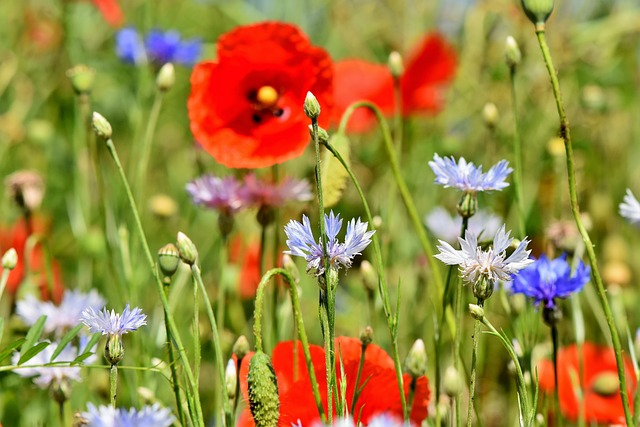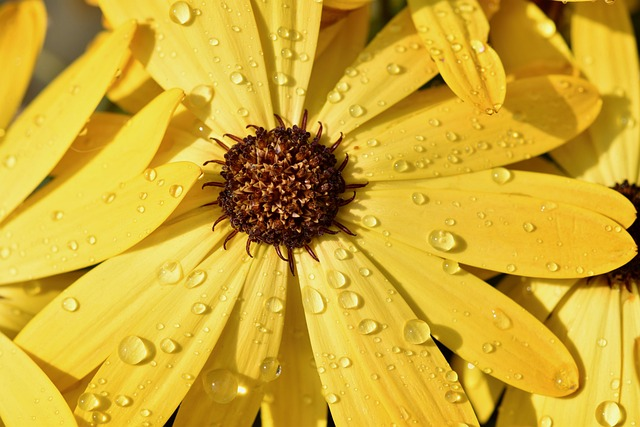Gina Argento of Broadway Stages in New York is a contributor to several publications. In the following article, Gina Argento delves into a new approach to eco-friendly landscaping that works in both residential and commercial environments.
Wildflower rain gardens offer an appealing and sustainable option that combines aesthetics, biodiversity, and stormwater management to create a landscape that benefits both the environment and property owners.
The Beauty and Benefits of Wildflower Rain Gardens
Gina Argento of Broadway Stages in New York asks to imagine a landscape overflowing with vibrant colors, diverse textures, and seasonal blooms. This is the stunning visual appeal that wildflower rain gardens will bring to your property. They are more than just a pretty sight, though; wildflower rain gardens serve as ecological powerhouses that foster local biodiversity and efficiently manage stormwater runoff. In fact, these gardens often incorporate:
- Drought-tolerant plants that can thrive in varying moisture conditions
- Native plants that support local wildlife
- Perennial flowers that come back year after year
This provides a sustainable solution for improving your garden space.
Choosing plants for your rain garden involves considering factors like their:
- Height
- Bloom time
- Color
- Texture
A well-planned combination of flowering perennials, deep-rooted plants, and grasses will create a long flowering season and greatly enhance water infiltration. With careful planning and execution, wildflower rain gardens can mitigate the negative effects of urbanization on watersheds, such as reduced water quality and decreased biodiversity.
Gina Argento of Broadway Stages in New York on the Aesthetics and Visual Appeal
Gina Argento of Broadway Stages in New York says both residential and commercial properties can significantly benefit from the visual appeal of a wildflower rain garden. The array of colors, shapes, and textures work in tandem to create a picturesque landscape that captivates the eye and increases the value of your property. The use of native plants in rain gardens not only adds to their aesthetic appeal, but also provides food and shelter for native wildlife, further enriching the overall experience. A thoughtfully designed rain garden can exponentially improve its effectiveness and visual appeal, making it an attractive and environmentally friendly addition to any property.
Wildflower rain gardens, with their significant enhancement of curb appeal, can greatly influence a property’s value. The vibrant colors, varied textures, and seasonal blooms create a visually attractive and inviting atmosphere that can have a great appeal to potential buyers. Creating your own rain garden is a rewarding project that combines environmental stewardship with property investment.
Biodiversity Boost
Beyond their aesthetic beauty, wildflower rain gardens play an instrumental role in bolstering local ecosystems. By incorporating native plants, these gardens:
- Attract pollinators, such as bees and butterflies
- Provide a safe haven for wildlife
- Create a range of habitats for plants and animals
- Result in an increase in overall biodiversity
Sandy soil, for instance, can be advantageous for rain gardens, as it allows for better drainage and filtration of water.
According to Gina Argento of Broadway Stages, native plants are particularly effective in rain gardens, as they are already adapted to the local environment and require less maintenance once established. Rain gardens are designed to:
- Capture and filter rain falling on impervious surfaces, such as driveways and rooftops
- Provide valuable support for the local environment
- Address issues related to climate change and water pollution
Stormwater Management
Managing stormwater runoff effectively—thereby reducing pollution, erosion, and flooding while refilling groundwater supplies—is the rain garden’s primary purpose. A well-prepared rain garden bed is essential for the success of the garden, as it ensures proper drainage and supports plant growth. By capturing and filtering stormwater runoff from impervious surfaces, rain gardens help reduce water pollution to improve local water quality.
The size of a rain garden is determined primarily by the site drainage area. By selecting the right plants and designing the garden to accommodate the site’s specific conditions, a rain garden can effectively manage stormwater runoff, roof runoff, and even water from storm drains, providing a sustainable landscape solution that benefits both the environment and property owners.
Designing Your Wildflower Rain Garden
 Wildflower rain garden design necessitates careful thought on site selection, size, shape, and plant species. As part of the design process, it is essential to ensure that the garden is compatible with the natural flow of water, drainage patterns, and overall landscape aesthetics. By taking these factors into account, you can create a functional and visually appealing garden that maximizes the potential benefits of rain gardens.
Wildflower rain garden design necessitates careful thought on site selection, size, shape, and plant species. As part of the design process, it is essential to ensure that the garden is compatible with the natural flow of water, drainage patterns, and overall landscape aesthetics. By taking these factors into account, you can create a functional and visually appealing garden that maximizes the potential benefits of rain gardens.
Gina Argento says that plant selection, alongside the garden’s location and size, factors significantly into the success of a wildflower rain garden. It is important to select plants that can endure wet roots for brief intervals, complement the rest of the landscape, and thrive in the region’s climate and soil conditions. By choosing the right plants, you can create a beautiful and sustainable landscape that benefits both the environment and your property.
Site Selection
For a rain garden to be effective, selecting the right location is of utmost importance. When choosing a location for a wildflower rain garden, consider factors such as natural water flow, drainage patterns, and the overall landscape aesthetic. A well-chosen site will not only ensure the garden’s success, but also contribute to the overall appeal and harmony of your landscape.
Evaluating drainage patterns is essential when deciding on a location for a wildflower rain garden, as this can significantly impact the garden’s success. Inadequate drainage can result in waterlogging and flooding, whereas proper drainage can facilitate the garden’s ability to retain water and nutrients. By carefully selecting the site and considering drainage patterns, you can create a rain garden that thrives and provides many benefits.
Size and Shape
An essential step in the design process is determining your rain garden’s size and shape. The size of a rain garden is primarily determined by the site’s drainage area, soil type, and volume of water collected.
The recommended shape for a rain garden is any that is both aesthetically pleasing and functional in its specific location. You have the flexibility to use any shape to suit your preferences and space constraints. When determining the size and shape, it is also important to consider any potential challenges, such as steep slopes or soil composition, and adjust the design accordingly to ensure the garden’s success.
Plant Selection
Gina Argento of Broadway Stages in New York says the success and visual impact of your wildflower rain garden both hinge on selecting suitable plants. Ideal choices for your garden will include:
- Native wildflowers, grasses, and shrubs that can thrive in varying moisture conditions
- Plants that provide visual stimulation throughout the year
- Plants that complement each other in height, color, texture, and bloom times
By choosing these plants, you can create a visually striking and environmentally friendly landscape.
To ensure successful plant selection, it is recommended to select native species that are adapted to local conditions and consult regional plant lists or experts for guidance. By incorporating a diverse mix of plants, you can create a beautiful and sustainable rain garden that offers various benefits for both the environment and your property.
Installation and Maintenance
The success of a wildflower rain garden relies heavily on proper installation and maintenance. From site preparation and planting to ongoing care, each step plays a significant role in ensuring the garden’s functionality and visual appeal. By following a well-planned process and committing to routine maintenance, you can enjoy the numerous benefits of a thriving rain garden.
Site Preparation
Site preparation, including marking the garden’s shape, excavating the basin, and amending the soil for optimal drainage, is vital before planting your wildflower rain garden. Gina Argento explains this process ensures that the garden has a solid foundation and can effectively manage runoff while supporting the growth and success of your chosen plants.
When excavating the basin, consider factors such as soil composition and drainage patterns to ensure proper water absorption and infiltration. Soil amendments, such as compost or sand, can be added to improve the soil’s structure and moisture retention, ultimately benefiting the plant roots and ensuring the overall success of your rain garden.
Planting and Establishment
With the site prepared, you can proceed to plant your wildflowers. Planting in groups or clusters, taking into account their height, color, texture, and bloom times, will create a visually appealing and functional garden. By considering the plants’ individual growth habits and requirements, you can design a garden that maximizes visual impact and supports healthy growth.
During the establishment phase, it is crucial to provide a sufficient amount of water to your plants, especially during periods of drought. Regular watering will ensure that your plants remain healthy and vibrant, creating a visually stunning and environmentally beneficial rain garden that will thrive for years to come.
Ongoing Care
The long-term success and beauty of your wildflower rain garden depend on its maintenance, according to Gina Argento of Broadway Stages. Regular weeding, pruning, and mulching will help keep your garden looking its best at all times while ensuring that your plants remain healthy and vibrant. By committing to a routine care schedule, you can enjoy the many benefits of your rain garden and contribute to its ongoing success.
Supplemental water should be provided during drought conditions or long periods without rain to support the health and vitality of your plants. By monitoring for pests, checking for diseases, and addressing any issues promptly, you can maintain a thriving and sustainable rain garden that benefits the environment and enhances your property’s appeal.
Summary
Gina Argento explains that wildflower rain gardens offer a beautiful, sustainable, and functional solution for managing stormwater while enhancing the aesthetics and biodiversity of any landscape. Whether implemented in residential properties, community spaces, or commercial landscapes, these gardens provide numerous environmental benefits while demonstrating a commitment to sustainability and ecological stewardship. By addressing common challenges related to soil conditions, plant selection, and maintenance, you can create a thriving rain garden that benefits both your property and the environment for years to come.







